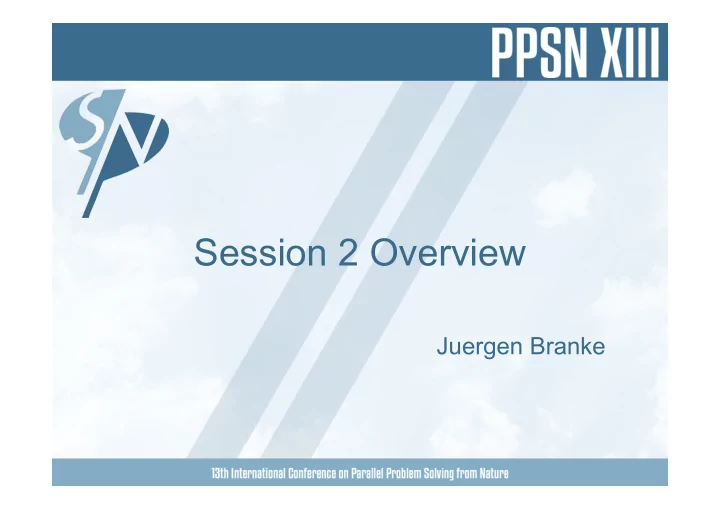

Session 2 Overview Juergen Branke
The Baldwin Effect Hinders Self-Adaptation Jim Smith • Two ways to improve final stage: – Memetic algorithms – self-adaptation • Interaction between Self-Adaptation and Baldwinian or Lamarckian learning • Lamarckian learning helps Self-Adaptation, Baldwinian learning slows it down Memetic algorithms, self-adaptation S2.1 ¡
A taxonomy of heterogeneity and dynamics in particle swarm optimisation Harry Goldingay, Peter Lewis • Heterogeneity: Particles with different behaviour • Dynamics: Particle behaviour changes over time • Dynamics often more useful than heterogeneity PSO, Self-adaptation S2.2 ¡
An Immune-Inspired Algorithm for the Set Cover Problem Ayush Joshi , Jonathan Rowe, Christine Zarges • Set cover with 2 objectives: – min number of subsets – min number uncovered elements • Parallel AIS based on germinal centre reaction in the immune system • Comparison with GSEMO AIS, Parallelization, Set Cover S2.3 ¡
Factoradic Representation for Permutation Optimisation Olivier Regnier-Coudert, John McCall • GA and 2 EDAs • 4 problems ( TSP, Permutation Flowshop Scheduling, Quadratic Assignment, Linear Ordering) • Factoradic representation works well in particular for UMDA EDA, permutation problems, representation S2.4 ¡
Inferring and Exploiting Problem Structure with Schema Grammar Chris Cox and Richard Watson • A model-building algorithm that is able to infer problem structure from fit individuals using generative grammar induction • Correlation between the compressibility of a population and the degree of inherent problem structure • Schemata inferred from the grammar can be exploited by an EA • NK landscapes EDA, Grammars, landscape analysis S2.5 ¡
Population Exploration on Genotype Networks in Genetic Programming Ting Hu, Wolfgang Banzhaf, Jason Moore • Linear GP • neutral networks to characterize the distribution of neutrality among genotypes and phenotypes • Correlation of the network properties with robustness and evolvability Genetic Programming, neutral networks, landscape analysis S2.6 ¡
A Provably Asymptotically Fast Version of the Generalized Jensen Algorithm for Non-Dominated Sorting Maxim Buzdalov, Anatoly Shalyto • New non-dominated sorting algorithm with better worst-case complexity EMO, algorithm complexity S2.7 ¡
Local Optimal Sets and Bounded Archiving on Multi- objective NK-Landscapes with Correlated Objectives Manuel López-Ibáñez , Arnaud Liefooghe, Sébastien Verel • Multi-objective NK-landscapes • Pareto Local Search • Analyse size of PLO-sets: – increasing the number of objectives -> exponential increment – decreasing the correlation between objectives -> exponential increment – variable correlation -> minor effect • time to reach PLOs when bounded archiving methods are used EMO, NK-landscapes, fitness landscape analysis, runtime analysis S2.8 ¡
Evolution-In-Materio: Solving Machine Learning Classification Problems Using Materials Maktuba Mohid, Julian Miller , Simon Harding, Gunnar Tufte, Odd Rune Lykkebø, Kieran Massey, Mike Petty • EIM: solution is implemented and tested on reconfigurable hardware • A mixture of single-walled carbon nanotubes and a polymer • Exploit the properties of physical matter to solve classification problems In-materio-evolution, in-the-loop evolution S2.9 ¡
Application of Evolutionary Methods to Semiconductor Double-Chirped Mirrors Design Rafal Biedrzycki, Jaroslaw Arabas , Agata Jasik, Michal Szymanski2, Pawel Wnuk, Piotr Wasylczyk, Anna Wójcik-Jedlinska • Design a mirror to be used in a laser • Comparison of CMA-ES , DE, Nelder- Mead, BFGS • Design is actually used Real-world application, algorithm comparison S2.10 ¡
A Memetic Algorithm For Multi Layer Hierarchical Ring Network Design Christian Schauer , Günther Raidl • large and reliable telecommunication networks • decomposition into – partitioning nodes into rings done by memetic algorithm – computation of ring for each partition done by heuristic decoder Representation, memetic algorithm, real-world application S2.11 ¡
A Generalized Markov-Chain Modelling Approach to (1, λ )-ES Linear Optimization Alexandre Chotard, Martin Holena • (1, λ )-ES with constant step size • linear problem with linear constraint • extension of previous work to non- Gaussian mutation Theory S2.12 ¡
Runtime Analysis of Evolutionary Algorithms on Randomly Constructed High-Density Satisfiable 3-CNF Formulas Andrew Sutton, Frank Neumann • Proves that for almost all satisfiable 3-CNF formulas, a simple 1+1 EA will find a satisfying assignment in O(n 2 log n) steps with high probability Theory S2.13 ¡
Enjoy the session!
Recommend
More recommend